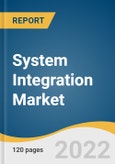The global system integration market size is expected to reach 955.21 billion by 2030, expanding at a CAGR of 13.2% from 2022 to 2030. The rising inclination towards cloud computing, demand for virtualization, and demand for low-cost and energy-efficient production processes are key factors that have positively influenced the industry growth. Automation technologies such as robotics and additive manufacturing (3D printing) can transform work patterns in both developed and emerging economies. Furthermore, due to high demand for these solutions, industries have realized the importance of modernizing the existing production facility. These factors are expected to propel the industry growth in the near future.
Surging adoption of cloud computing and numerous developments in virtual technologies is projected to trigger the adoption of system integration solutions. Technological advancements, such as Cloud Service Brokerage (CSB), Building Energy Management Systems (BEMS), Cyber-Physical System (CPS), and clinical integration is anticipated to offer new opportunities for market growth. For instance, in August 2021, the government of UAE funded various projects, such as Smart Abu Dhabi and Smart Dubai, aimed at bringing digital transformation and accelerating economic growth. This strategy aimed at providing better digital infrastructure and raise the levels of digital capabilities and skills.
Several key market players are focusing on mergers, acquisitions, and collaborations to enhance their market presence. With this, it will record an increase in operational efficiency and revenue generation. For instance, in February 2020, Trianz announced a partnership with ServiceNow, a software-based company that develops a cloud computing platform to help companies manage digital workflows for enterprise operations. With this partnership, Trianz aims at integrating a ServiceNow product line into its business model and provide strategic consulting and implementation services with advanced automation capabilities that align with the clients’ digital transformation strategy. These strategic partnerships are expected to be focused on developing system integration services solutions, such as tools, platforms, and consulting services.
Surging adoption of cloud computing and numerous developments in virtual technologies is projected to trigger the adoption of system integration solutions. Technological advancements, such as Cloud Service Brokerage (CSB), Building Energy Management Systems (BEMS), Cyber-Physical System (CPS), and clinical integration is anticipated to offer new opportunities for market growth. For instance, in August 2021, the government of UAE funded various projects, such as Smart Abu Dhabi and Smart Dubai, aimed at bringing digital transformation and accelerating economic growth. This strategy aimed at providing better digital infrastructure and raise the levels of digital capabilities and skills.
Several key market players are focusing on mergers, acquisitions, and collaborations to enhance their market presence. With this, it will record an increase in operational efficiency and revenue generation. For instance, in February 2020, Trianz announced a partnership with ServiceNow, a software-based company that develops a cloud computing platform to help companies manage digital workflows for enterprise operations. With this partnership, Trianz aims at integrating a ServiceNow product line into its business model and provide strategic consulting and implementation services with advanced automation capabilities that align with the clients’ digital transformation strategy. These strategic partnerships are expected to be focused on developing system integration services solutions, such as tools, platforms, and consulting services.
System Integration Market Report Highlights
- The consulting segment accounts for a market share of over 30% in 2021. The segment growth can be attributed to the rising need for enterprises to harness the power of technology required for businesses to overcome complex system integration challenges. It includes program integration and management, solution integration, and system development.
- The IT & telecom segment is expected to witness significant growth of CAGR of 15.6% during the forecast period owing to increased penetration of 4G services and growing development of 5G infrastructure that has data-intensive networks and may lead to huge data generation. Additionally, a growing number of telecom subscribers using smartphones and other handheld devices worldwide is anticipated to influence the segment’s growth positively.
- The Asia Pacific regional market is expected to reach USD 286.56 billion by 2030. The rapidly growing investments to support the installation of 5G infrastructure in emerging economies such as China, India, and South Korea is likely to create significant opportunities for system integration services in the region. In addition to this, these investments are envisioned to focus on implementing next-generation infrastructure for various industry verticals, including transportation, energy and utility, healthcare, and manufacturing.
Table of Contents
Chapter 1. Methodology and Scope
Chapter 2. Executive Summary
Chapter 3. System Integration Market: Industry Outlook
Chapter 4. System Integration Market: Services Segment Analysis
Chapter 5. System Integration Market: End-use Segment Analysis
Chapter 6. System Integration Market: Region Segment Analysis
Chapter 7 Competitive Analysis
Chapter 8 Competitive Landscape
Companies Mentioned
- Accenture
- Capgemini
- Cisco Systems, Inc.
- Cognizant
- Deloitte Touche Tohmatsu Limited
- International Business Machines Corporation
- Infosys Limited
- Oracle Corporation
- Tata Consultancy Services Limited
- Tech Mahindra Limited
Methodology

LOADING...
Table Information
| Report Attribute | Details |
|---|---|
| No. of Pages | 120 |
| Published | April 2022 |
| Forecast Period | 2022 - 2030 |
| Estimated Market Value ( USD | $ 353.92 Billion |
| Forecasted Market Value ( USD | $ 955.21 Billion |
| Compound Annual Growth Rate | 13.2% |
| Regions Covered | Global |
| No. of Companies Mentioned | 10 |









